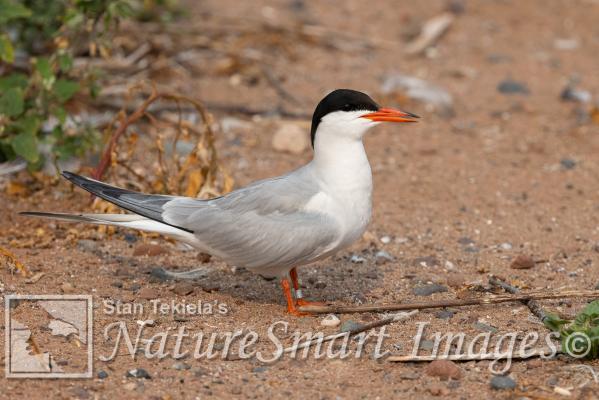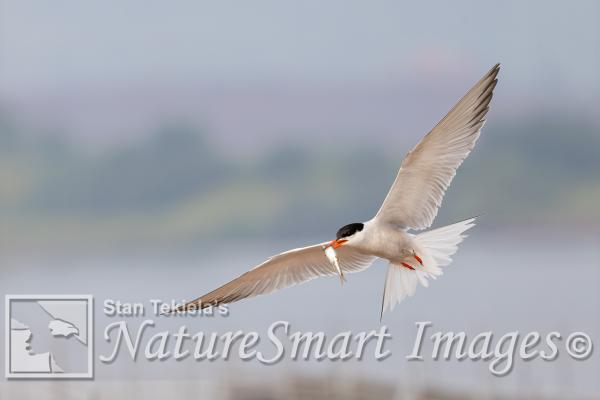View all of the titles in the
NatureSmart Bookstore


by Stan Tekiela
© NatureSmart
September 20, 2021
Every now and then I meet a true wildlife superhero. You know, the kind of person who has dedicated their life to understand and protecting wildlife. And even after many decades they are still interested in learning more and doing the hard work that it takes to protect an endangered species. Recently I met such a superhero/biologist while doing some research for this story. Although it wasn’t obvious, I think I caught a glimpse of his superhero cape tucked under his collar when we met up last week.
Fred Strand formerly from the Wisconsin DNR has studied the not so common, Common Tern (Sterna hirundo) since the late 1980’s. He is now contracted by Wisconsin DNR and volunteers for the Minnesota DNR to monitor and manage habitat for the only Common Tern colonies in the Great Lakes area.
The common names of birds are often problematic in that the common name often doesn’t help to identify the species or indicate their abundance. Take the Common Tern for example. The name would imply that it is a “common” bird, when in fact in the northland, this bird is anything but common. In states like Wisconsin, the Common Tern is listed as an Endangered species while in Minnesota it is listed as Threatened. The U.S. Fish and Wildlife Service lists the Common Tern as a species of Special Concern.
The Common Tern is found circumpolar. Which means it is found around the globe in northern temperate and subarctic regions of Europe, Asia, and North America. Populations have been declining especially in the Great Lakes where it is estimated that less than 10,000 pairs are breeding. The population in North America has fallen by more than 70 percent in the last 40 to 50 years.
The reasons for these declines are multi fold. Loss of nesting habitat is a big one. The Common Tern is a colony nesting species that resides on small islands in large bodies of water. Often these nesting colonies are disturbed by boaters, kayakers and other human activity including beach combing and dog walking. Believe it or not another problem is vegetation. If the vegetation becomes too thick on the island the birds will move out. Predators such as rats, raccoons and skunks are another problem. Another big issue are gulls, which also have similar nesting requirements, and are larger and simply push out the terns. In addition, the gulls often prey on the smaller Common Tern and especially their newly hatched chicks.
Tiny metal bands are placed on the legs of young terns just after hatching which allows researchers to track the birds that are captured later in life. Common Terns are long-lived birds with the average age of an adult being about 10 years. You might have seen recently in the news that an adult Common Tern was recaptured near Ashland Wisconsin and was found to be nearly 27 years old. The oldest known Common Tern is 28 years and 11 months.
Common Terns are extremely long-distance migrators. Through a partnership with the Natural Resources Research Institute in Duluth, Minnesota, the biologists are using geolocators to track the tern migration. So far, the research shows that about 70 percent of the Common Terns that nest in the Great Lakes region overwinter along the coast of Peru in South America, which means they travel nearly 10,000 miles roundtrip each year. And you thought you had a tough commute to work!
It is important to understand that the terns don’t nest during the winter while they are in Peru. They rest during winter and fly all the way back to the tiny islands in the Great Lakes region to nest again next year. At this point it should be painfully obvious that protecting the nesting habitat of these elegant birds is extremely important and the work that Fred is doing is mission critical.
Standing with Fred, on a small island, surrounded by nesting Common Terns, he explained the importance of the work taking place here. It is very clear that these birds are just trying to do what we all are trying to do… have a good life and raise a few children. It seems obvious to me that we need a lot more wildlife Superhero’s like Fred. Until next time…
Stan Tekiela is an author / naturalist and wildlife photographer who travels the U.S. to study and photograph wildlife. He can be followed on facebook.com, twitter.com and Instagram.com. He can be contacted via his web page at naturesmart.com.
The nationally syndicated NatureSmart Column appears in over 25 cities spanning 7 states: Minnesota, Wisconsin, Michigan, Illinois, Ohio, New York and Pennsylvania. It is a bi-weekly column circulated to over 750,000 readers.
Wolves
Just the day before, a pack of wolves known as the Wapiti, had found a large bull bison that was weak and injured. Based on its size, this big boy was near the end of its lifespan and the winter weather was taking its toll. For a full day the wolves tried to approach the bison but when the bison...
Moose
It was one of those dark and cloudy winter days in Yellowstone National Park where the clouds are so heavy and low, you feel like you can reach up and touch the cloudy sky. A light wind helped to blow the falling snow with occasional gusts of wind causing swirls of fluffy white snow...
American Badger
It’s funny, I believe the average person knows more about the Honey Badger (Mellivora capensis), a critter of Africa and Southwest Asia than they do about the badger in our own backyard, the American Badger (Taxidea taxus). Social media has a lot to do with the Honey Badger phenomena and...
Backyard Bird Feeding
Winter bird feeding is one of the most common / popular hobbies in America. It is estimated that nearly 60 million Americans feed birds in their yards in winter or summer. That is about 40 percent of all American’s make backyard bird feeding part of their everyday activities. It’s...
Each year, during June and July, Stan Tekiela offers two world-class wildlife photography tours. Here's your chance to learn some tricks of the trade from a top professional.
View all of the titles in the
NatureSmart Bookstore
Check out Stan's latest photos at
NatureSmart Wildlife Images
Do you have any interesting wildlife in your backyard? Any nesting birds, deer, turkeys, reptiles, amphibians, or other unique wildlife? Or maybe a fox or coyote den?
If so, contact Stan at stan@naturesmart.com with your backyard wildlife. If he can get a good photo of the subject, he will send you a print of the photo to hang on your wall.
Order Prints and posters of Stan's photos at
» Prints & Posters
Hear Stan on radio stations all across the Midwest.
» More Info

When he's out in the field, Stan relies on his Vortex Razor binoculars and Vortex Razor spotting scope to help find the subjects for his award winning wildlife photography.

For thirty years, professional wildlife photographer Stan Tekiela has counted on Hunt's Photo and Video to provide him with professional photography equipment.
From tripods to camera bodies and lenses, Hunt's has been Stan's place for everything that he needs. Personal service and prompt shipping means Stan can count on Hunt's to support his professional wildlife photography career.


Professional Wildlife Photographer Stan Tekiela always uses Feeder Fresh in his seed feeders to help keep the feeders and food dry, clean and mold free.
He also uses Feeder Fresh Nectar Defender in all of his hummingbird feeders. It safely keeps nectar fresh longer.